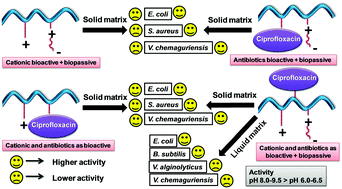Matrix assisted antibacterial activity of polymer conjugates with pendant antibiotics, and bioactive and biopassive moieties†
Abstract
Antibacterial activity against a series of potentially pathogenic bacterial strains was evaluated in both liquid and solid matrices using ciprofloxacin (a well-known fluoroquinolone antibiotic) based polymeric systems with pendant cationic charge and zwitterionic units. The ciprofloxacin containing polymeric architecture was designed to incorporate bioactive killing properties of cationic moieties, whereas biopassive activity was regulated by the bacterial cell repelling capacity of the zwitterionic group. tert-Butyl carbamate (Boc)-leucine hydroxyethylmethacrylate (Boc-Leu-HEMA), Boc-ciprofloxacin hydroxyethylmethacrylate (Boc-Cipro-HEMA) and zwitterionic sulphabetaine methacrylate (SBMA) are copolymerized, followed by deprotection of Boc groups from the copolymer under acidic conditions. Boc deprotection resulted in water soluble polymers with cationic charge from the leucine moiety and retained the antibiotics in their active original form. The antibacterial activity of the polymeric system was evaluated against several bacterial species, namely, Escherichia coli (E. coli), Bacillus subtilis (B. subtilis), Staphylococcus aureus (S. aureus), Vibrio alginolyticus (V. alginolyticus), and Vibrio chemaguriensis Iso1 (V. chemaguriensis), in both liquid and solid matrices. The copolymer displayed significant bactericidal efficacy against non-biofilm forming E. coli and B. subtilis in both liquid and solid matrices. However, the antibacterial effect on biofilm forming V. chemaguriensis was comparatively less prominent in the liquid matrix. Optical microscope images of Gram staining revealed an enhanced surface area of individual cells and chain formation in cells of V. chemaguriensis. The non-cytotoxic profile of the polymer towards mammalian red blood cells (RBCs) and enhanced bactericidal effect in the physiological to basic pH (7.0–9.5) range against potentially pathogenic V. chemaguriensis using a multitude of microscopic techniques hinted toward the need to develop new antibiotics to combat possible clinical infections in the near future.



 Please wait while we load your content...
Please wait while we load your content...